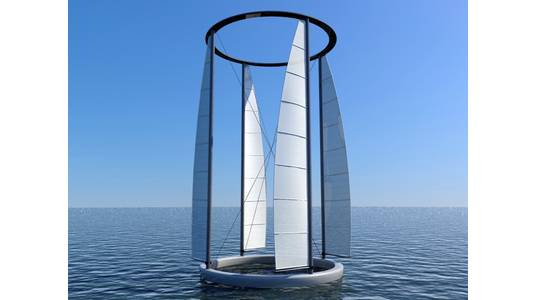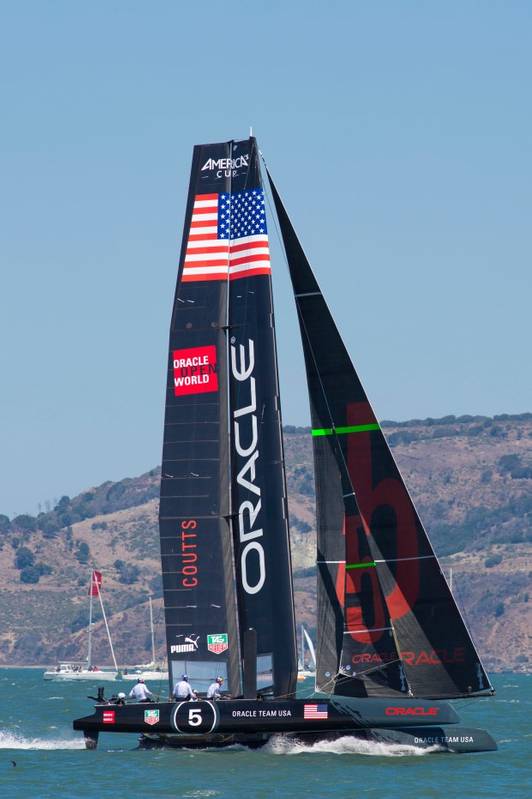
American Offshore Energy (AOE) has this week announced novel patents in the floating wind turbine industry including a vertical axis wind turbine which, the company says, can be deployed quickly, and even submerged in the wake of a hurricane.
AOE said said: "The AOE VAWT design, the "American Turbine", is the first wind turbine that has no center shaft, the bearings and electrical generation move to the perimeter where there are high surface speeds even at low RPMs, eliminating the need for rolling bearings, gearboxes, and oil.
"Maybe more importantly, the team at AOE used clever design principles to completely avoid moment forces being transmitted to the floating base; this means the floats may be made from fiberglass, saving thousands of tons of steel,"
The company said that it "took a page from Americas Cup Sailboat Racing to build a lightweight but powerful aerodynamic rotor that may be "trimmed" to conditions."
"The big idea is that to make a floating wind turbine, it makes more sense to reach up into the wind with a lightweight structure, like a cross between sailboat masts and bicycle wheels, keeping the heavier bearings and generator near sea level. Turbines that have been successful on land are being put on floating structures only because they are the dominant wind turbine technology, not because someone thought rationally about how best to make a floating wind turbine. This creates a huge opportunity. The key technologies enabling the opportunity are water-based hydrostatic perimeter support bearings, direct drive HVDC generation at the perimeter and tension and compression design principles," AOE said.
"Because of the fluid film bearing technology, axial and radial loads are separated; this means that the axial bearings, carrying the weight of the rotating assembly, may push down or pull up on a float, but cannot introduce a moment load. Because the floats are loaded in only tension or compression, they may be made from fiberglass at a tenth of the weight per MW of the oil derrick-like floats required for HAWT [Horizontal Axis Wind Turbine] designs," AOE added.
According to the company, HAWT have the loads and masses at the top of a long pole, they are cantilevered, so a 50-ton force at the top of a 100-meter tower puts more than 500 tons of force into a floating base that is holding the bottom 10 meters.
"This is why they require so much steel. The AOE design avoids this," AOE said.
AOE says that its design has no need for forgings, castings, rolling element bearings, gearboxes, conventional generators, or AC/DC conversions at sea.
"Being so much lighter, they may be manufactured and launched from sites not appropriate for launching floating HAWTs, and so are not competitive in regard to coastal real estate either," AOE says.
Made in the U.S.
"The fact that they may be towed and serviced by existing Jones Act-compliant vessels sidesteps another logistical supply chain problem. The AOE turbine is constructed of fabricated steel and fiberglass structures, both active industries here in the USA that could easily scale up," AOE says.
Drew Devitt, CTO of AOE notes, "Being completely American-made, we will avoid having to wait to buy European-made nacelles; that is another reason we may be able to deploy faster and less expensively." He goes on: "We are not competing with HAWT; we really offer a completely different 'Iron in the Fire' with regard to deploying utility-scale floating wind turbines."
Asked about what distinguishes AOE from other VAWT offerings, Devitt says, "It goes back to our 'No Shaft' design. All the other VAWT offerings employ a center shaft. The center shaft VAWT have an advantage over HAWTs in regard to floating, by having the mass of the bearings, gearbox and generator at or below sea level. But they still are on the wrong end of 10 to 1 leverage, and in their case, this force is transmitted through rolling element bearings. And still, they need a gearbox, as generating power at 10rpm would require a huge generator. The cost, the shafted VAWTs will pay, that shafted HAWT guys do not have, will be trying to keep saltwater out of oil-lubricated turbine bearings, gearbox and generator that is at or below sea level."
According to AOE, in its design, there are no rolling bearings or gearboxes and so no oil, the turbines may be sunk in the face of a hurricane, allowing the turbines to ride out the storm just below the ocean surface.
"This dramatically reduces risk, and so the cost for financing and insurance. The turbines can be raised after the storm by remotely releasing compressed air cylinders in the fiberglass floats. General maintenance at sea is facilitated as the bearings and generator components are at deck level for service boats and because the turbines are arranged in a mooring field, they may be unplugged and towed back to port in a day by existing Jones Act-compliant tugs for maintenance if necessary. The large surface area of the vertical wings is obvious to birds and gives strong horizontal radar reflection for maritime navigation, with no vertical reflection for aero navigation," the company said.
Devit said that speed to deployment is the key advantage of the technology.
"Steel and fiberglass fabrication have relatively low capital requirements. Combine that with low real estate costs, near the proposed wind farms, and you have a recipe for franchising manufacturing. Once the facility and tooling to make the turbines have been developed, they can be duplicated, and other manufacturing sites could pop up quickly near deployment sites. This would be a great way to help us meet our renewable energy targets and put Americans to work quickly," Devit said.



